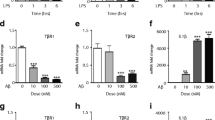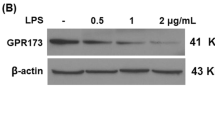Abstract
Delivery of exogenous heat shock protein 90α (Hsp90α) and/or its induced expression in neural tissues has been suggested as a potential strategy to combat neurodegenerative disease. However, within a neurodegenerative context, a pro-inflammatory response to extracellular Hsp90α (eHsp90α) could undermine strategies to use it for therapeutic intervention. The aim of this study was to investigate the biological effects of eHsp90α on microglial cells, the primary mediators of inflammatory responses in the brain. Transcriptomic profiling by RNA-seq of primary microglia and the cultured EOC2 microglial cell line treated with eHsp90α showed the chaperone to stimulate activation of innate immune responses in microglia that were characterized by an increase in NF-kB-regulated genes. Further characterization showed this response to be substantially lower in amplitude than the effects of other inflammatory stimuli such as fibrillar amyloid-β (fAβ) or lipopolysaccharide (LPS). Additionally, the toxicity of conditioned media obtained from microglia treated with fAβ was attenuated by addition of eHsp90α. Using a co-culture system of microglia and hippocampal neuronal cell line HT22 cells separated by a chamber insert, the neurotoxicity of medium conditioned by microglia treated with fAβ was reduced when eHsp90α was also added. Mechanistically, eHsp90α was shown to activate Nrf2, a response which attenuated fAβ-induced nitric oxide production. The data thus suggested that eHsp90α protects against fAβ-induced oxidative stress. We also report eHsp90α to induce expression of macrophage receptor with collagenous structure (Marco), which would permit receptor-mediated endocytosis of fAβ.








Similar content being viewed by others
Change history
13 July 2022
A Correction to this paper has been published: https://doi.org/10.1007/s12192-022-01285-x
References
Alarcon R et al (2005) Expression of scavenger receptors in glial cells. Comparing the adhesion of astrocytes and microglia from neonatal rats to surface-bound beta-amyloid. J Biol Chem 280(34):30406–15
Andrews S (n.d.) FastQC: a quality control tool for high throughput sequence data. Available online at: 2010; Available from: http://www.bioinformatics.babraham.ac.uk/projects/fastqc
Bolger AM, Lohse M, Usadel B (2014) Trimmomatic: a flexible trimmer for Illumina sequence data. Bioinformatics 30(15):2114–2120
Branca C et al (2017) Genetic reduction of Nrf2 exacerbates cognitive deficits in a mouse model of Alzheimer’s disease. Hum Mol Genet 26(24):4823–4835
Calderwood SK, Gong J, Murshid A (2016) Extracellular HSPs: the complicated roles of extracellular HSPs in immunity. Front Immunol 7:159
Calderwood SK, Murshid A (2017) Molecular chaperone accumulation in cancer and decrease in Alzheimer’s disease: the potential roles of HSF1. Front Neurosci 11:192
Cherry JD, Olschowka JA, O’Banion MK (2014) Neuroinflammation and M2 microglia: the good, the bad, and the inflamed. J Neuroinflammation 11:98
Clayton KA, Van Enoo AA, Ikezu T (2017) Alzheimer’s disease: the role of microglia in brain homeostasis and proteopathy. Front Neurosci 11:680
Clement M et al (2016) Necrotic cell sensor Clec4e promotes a proatherogenic macrophage phenotype through activation of the unfolded protein response. Circulation 134(14):1039–1051
Dobin A et al (2013) STAR: ultrafast universal RNA-seq aligner. Bioinformatics 29(1):15–21
Frankish A et al (2019) GENCODE reference annotation for the human and mouse genomes. Nucleic Acids Res 47(D1):D766–D773
Fujimoto M et al (2005) Active HSF1 significantly suppresses polyglutamine aggregate formation in cellular and mouse models. J Biol Chem 280(41):34908–34916
Garigan D et al (2002) Genetic analysis of tissue aging in Caenorhabditis elegans: a role for heat-shock factor and bacterial proliferation. Genetics 161(3):1101–1112
Generation of anti-tumor immunity using mammalian heat shock protein 70 DNA (2006) 24(25)
Gong J et al (2018) Genotoxic stress induces Sca-1-expressing metastatic mammary cancer cells. Mol Oncol 12(8):1249–1263
Guzhova I et al (2001) In vitro studies show that Hsp70 can be released by glia and that exogenous Hsp70 can enhance neuronal stress tolerance. Brain Res 914(1–2):66–73
Hancock MK et al (2015) A facile method for simultaneously measuring neuronal cell viability and neurite outgrowth. Curr Chem Genom Transl Med 9:6–16
Hanisch UK (2002) Microglia as a source and target of cytokines. Glia 40(2):140–155
Heinz S et al (2010) Simple combinations of lineage-determining transcription factors prime cis-regulatory elements required for macrophage and B cell identities. Mol Cell 38(4):576–589
Hsu AL, Murphy CT, Kenyon C (2003) Regulation of aging and age-related disease by DAF-16 and heat-shock factor. Science 300(5622):1142–1145
Huang B et al (2010) Posttranslational modifications of NF-kappaB: another layer of regulation for NF-kappaB signaling pathway. Cell Signal 22(9):1282–1290
Huang HC, Nguyen T, Pickett CB (2002) Phosphorylation of Nrf2 at Ser-40 by protein kinase C regulates antioxidant response element-mediated transcription. J Biol Chem 277(45):42769–42774
Ikezu S et al (2020) Inhibition of colony stimulating factor 1 receptor corrects maternal inflammation-induced microglial and synaptic dysfunction and behavioral abnormalities. Mol Psychiatry
Janda E, Boi L, Carta AR (2018) Microglial phagocytosis and its regulation: a therapeutic target in Parkinson’s disease? Front Mol Neurosci 11:144
Keenan AB et al (2019) ChEA3: transcription factor enrichment analysis by orthogonal omics integration. Nucleic Acids Res 47(W1):W212–W224
Kirkegaard T et al (2016) Heat shock protein-based therapy as a potential candidate for treating the sphingolipidoses. Sci Transl Med 8(355):355ra118
Kissick HT et al (2014) The scavenger receptor MARCO modulates TLR-induced responses in dendritic cells. PLoS One 9(8):e104148
Krasemann S et al (2017) The TREM2-APOE pathway drives the transcriptional phenotype of dysfunctional microglia in neurodegenerative diseases. Immunity 47(3):566-581. e9
La Fleur L et al (2021) Targeting MARCO and IL37R on immunosuppressive macrophages in lung cancer blocks regulatory T cells and supports cytotoxic lymphocyte function. Cancer Res 81(4):956–967
Lang BJ et al (2018) A workflow guide to RNA-seq analysis of chaperone function and beyond. Methods Mol Biol 1709:233–252
Lang BJ et al (2021) The functions and regulation of heat shock proteins; key orchestrators of proteostasis and the heat shock response. Arch Toxicol 95(6):1943–1970
Lee YB, Nagai A, Kim SU (2002) Cytokines, chemokines, and cytokine receptors in human microglia. J Neurosci Res 69(1):94–103
Li W, Sahu D, Tsen F (2012) Secreted heat shock protein-90 (Hsp90) in wound healing and cancer. Biochim Biophys Acta 1823(3):730–741
Murshid A et al (2015) Scavenger receptor SREC-I mediated entry of TLR4 into lipid microdomains and triggered inflammatory cytokine release in RAW 264.7 cells upon LPS activation. PLoS One 10(4):e0122529
Murshid A et al (2021) Extracellular Hsp90α Detoxifies β-amyloid fibrils through an NRF2 and autophagy dependent pathway. bioRxiv
Murshid A, Gong J, Calderwood SK (2010) Heat shock protein 90 mediates efficient antigen cross presentation through the scavenger receptor expressed by endothelial cells-I. J Immunol 185(5):2903–2917
Netea-Maier RT et al (2016) Modulation of inflammation by autophagy: consequences for human disease. Autophagy 12(2):245–260
Nguyen T, Sherratt PJ, Pickett CB (2003) Regulatory mechanisms controlling gene expression mediated by the antioxidant response element. Annu Rev Pharmacol Toxicol 43:233–260
Numazawa S et al (2003) Atypical protein kinase C mediates activation of NF-E2-related factor 2 in response to oxidative stress. Am J Physiol Cell Physiol 285(2):C334–C342
Okusha Y et al (2020) Rab11A functions as a negative regulator of osteoclastogenesis through dictating lysosome-induced proteolysis of c-fms and RANK surface receptors. Cells 9:2384
Rampelt H et al (2012) Metazoan Hsp70 machines use Hsp110 to power protein disaggregation. EMBO J 31(21):4221–4235
Reddy NM et al (2009) Innate immunity against bacterial infection following hyperoxia exposure is impaired in NRF2-deficient mice. J Immunol 183(7):4601–4608
Robinson MD, McCarthy DJ, Smyth GK (2010) edgeR: a bioconductor package for differential expression analysis of digital gene expression data. Bioinformatics 26(1):139–140
Stansley B, Post J, Hensley K (2012) A comparative review of cell culture systems for the study of microglial biology in Alzheimer’s disease. J Neuroinflammation 9:115
Takahama M, Akira S, Saitoh T (2018) Autophagy limits activation of the inflammasomes. Immunol Rev 281(1):62–73
Taylor AR et al (2007) Regulation of heat shock protein 70 release in astrocytes: role of signaling kinases. Dev Neurobiol 67(13):1815–1829
Thawkar BS, Kaur G (2019) Inhibitors of NF-kappaB and P2X7/NLRP3/caspase 1 pathway in microglia: novel therapeutic opportunities in neuroinflammation induced early-stage Alzheimer’s disease. J Neuroimmunol 326:62–74
Theriault JR, Adachi H, Calderwood SK (2006) Role of scavenger receptors in the binding and internalization of heat shock protein 70. J Immunol 177(12):8604–8611
Tidwell JL, Houenou LJ, Tytell M (2004) Administration of Hsp70 in vivo inhibits motor and sensory neuron degeneration. Cell Stress Chaperones 9(1):88–98
Timmerman R, Burm SM, Bajramovic JJ (2018) An overview of in vitro methods to study microglia. Front Cell Neurosci 12:242
van Oosten-Hawle P, Morimoto RI (2014) Transcellular chaperone signaling: an organismal strategy for integrated cell stress responses. J Exp Biol 217(Pt 1):129–136
Wang X, Seed B (2003) A PCR primer bank for quantitative gene expression analysis. Nucleic Acids Res 31(24):e154
Wilkinson K, El Khoury J (2012) Microglial scavenger receptors and their roles in the pathogenesis of Alzheimer’s disease. Int J Alzheimers Dis 2012:489456
Wu R et al (2020) ACOD1 in immunometabolism and disease. Cell Mol Immunol 17(8):822–833
Yamamoto M et al (2008) Cytokine-mediated inhibition of fibrillar amyloid-beta peptide degradation by human mononuclear phagocytes. J Immunol 181(6):3877–3886
Yu G et al (2012) clusterProfiler: an R package for comparing biological themes among gene clusters. OMICS 16(5):284–287
Zhang Y et al (2018) TREM2 modulates microglia phenotypes in the neuroinflammation of Parkinson’s disease. Biochem Biophys Res Commun 499(4):797–802
Acknowledgements
We wish to thank the Department of Radiation Oncology for their continued support. Suraya Yasmine, Reeham Choudhury and Lay-Hong Ang are thanked for fine technical contributions. We thank Harvard Biopolymers Facility and Harvard Research Computing for their technical support. Figures 2A and 4A were made with Biorender.com.
Author information
Authors and Affiliations
Corresponding authors
Ethics declarations
Conflict of interest
The authors declare no competing interests.
Additional information
Publisher's note
Springer Nature remains neutral with regard to jurisdictional claims in published maps and institutional affiliations.
The original version of this article was revised: due to a technical error Figures 1 and 2 were incomplete. Figs 1F, 1G and Figs 2G, 2H have been added.
Supplementary Information
Below is the link to the electronic supplementary material.

12192_2022_1279_Fig7_ESM.png
Supplementary Fig. 1 (PNG 705 KB) (A) Gene set enrichment GO analysis of DEG list of cultured primary microglia treated with or without 10 µg/ml Hsp90α for 12 h. B Relative levels of mRNAs in EOC2 cells and primary microglia treated with or without 10 µg/ml Hsp90α for 4 h or 12 h, respectively, that were found to be differentially expressed and that have been categorized under GO:1901701 ‘cellular response to oxygen-containing compound’. Gene expression levels were quantified by RNA-seq and the relative levels shown are z-scores of TMM-normalized counts.

12192_2022_1279_Fig8_ESM.png
Supplementary Fig. 2 (PNG 543 KB) (A) Relative levels of Marco mRNA in EOC2 cells treated with or without 10 µg/ml Hsp90α for 4 h, quantified by RNA-seq. Relative levels shown are z-scores of TMM-normalized counts. Fold change was determined using the edgeR statistical package. B RT-qPCR quantitation of Marco normalized to Rpl32 in BV2 cells after 12 h. * p < 0.05. n=4. C Quantitation of Immunofluorescence staining for Marco in paraformaldehyde fixed EOC2 cells treated with 10 µg/ml Hsp90α for 24 h, scale bar =100 µm. n=3. D BV2 cells were treated with Nrf2 inhibitor ML385 (ML) or vehicle control for the indicated periods at which time levels of Nrf2-encoding mRNA (Nfe2l2) were assessed.
Rights and permissions
About this article
Cite this article
Okusha, Y., Lang, B.J., Murshid, A. et al. Extracellular Hsp90α stimulates a unique innate gene profile in microglial cells with simultaneous activation of Nrf2 and protection from oxidative stress. Cell Stress and Chaperones 27, 461–478 (2022). https://doi.org/10.1007/s12192-022-01279-9
Received:
Revised:
Accepted:
Published:
Issue Date:
DOI: https://doi.org/10.1007/s12192-022-01279-9




